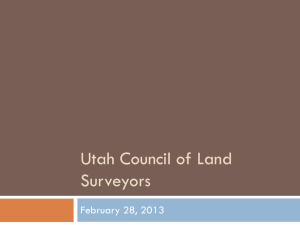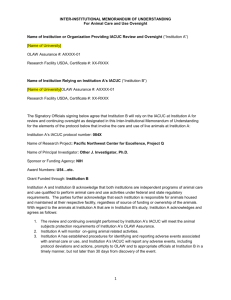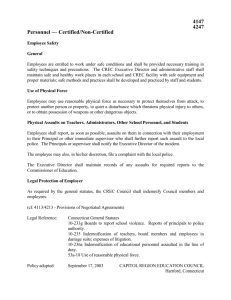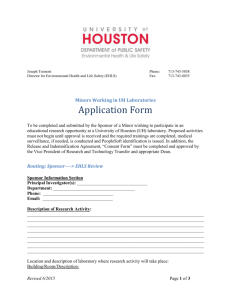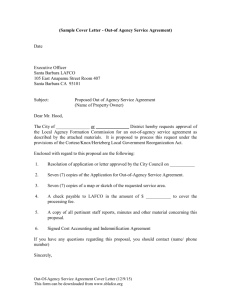Indemnification Clauses - Association of Corporate Counsel
advertisement
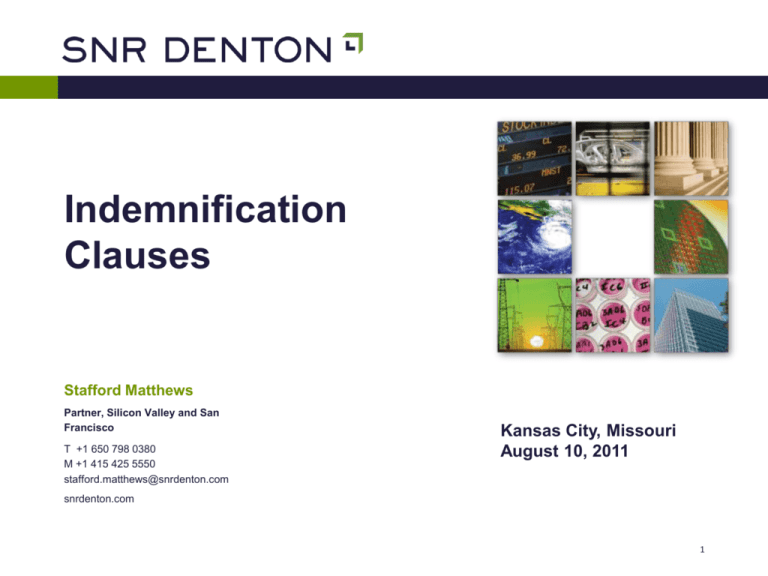
Indemnification Clauses Stafford Matthews Partner, Silicon Valley and San Francisco T +1 650 798 0380 M +1 415 425 5550 stafford.matthews@snrdenton.com Kansas City, Missouri August 10, 2011 snrdenton.com 1 About SNR Denton SNR Denton is a client-focused international legal practice delivering quality and value. We serve clients in key business and financial centers from 60 locations in 43 countries, through offices, associate firms and special alliances across the US, UK, Europe, the Middle East, Russia and the CIS, Asia Pacific, and Africa, making us a top 25 legal services provider by lawyers and professionals worldwide. Joining the complementary top tier practices of its founding firms—Sonnenschein Nath & Rosenthal LLP and Denton Wilde Sapte LLP—SNR Denton offers business, government and institutional clients premier service and a disciplined focus to meet evolving needs in eight key industry sectors: Energy, Transport and Infrastructure; Financial Institutions and Funds; Government; Health and Life Sciences; Insurance; Manufacturing; Real Estate, Retail and Hotels; and Technology, Media and Telecommunications. 2 Our Locations 3 I. Indemnification - Basic principles 4 Basic principles* Indemnification is a contractual obligation by one party [X] to pay or compensate for the losses or damages or liabilities incurred by another party to the contract [Y] or by some third person. An indemnitor is the party who is obligated to pay another. An indemnitee is the party who is entitled to receive the payment from the indemnitor. * Note that the following presentation deals with agreements and licenses between corporate or other commercial parties, and does not cover contracts in regulated industries such as insurance. 5 Basic principles Common types of losses subject to contractual indemnification: • Breach of representation or warranty by [X]. • Breach of agreement or covenant by [X]. • Losses incurred by [Y] under specified conditions. • Third party claims against [Y] for specific subject matter, such as (1) claims of infringement or misappropriation of IP, (2) use of goods by the indemnitee, (3) product defect or liability claims, (4) claims arising out of death or personal injury. 6 Function of indemnification – Risk shifting Indemnification provisions are a means of shifting risk between parties to an agreement. Part of an integrated risk allocation system also comprised of: Representations and warranties of the parties, including disclaimers of implied warranties and exclusions and limitations based on disclosure schedules. Limitations of liabilities such as consequential and related damages and contractual ―caps‖ on liabilities. Contractual statutes of limitation. Insurance. 7 Function of indemnification – Adjustment of value In addition a mechanism to reallocate economic value in a transaction, even when neither party is culpable: In an acquisition transaction, adjusts purchase price by reallocating consideration based on issues that arise after deal is signed or closed. In licensing or commercial transactions, apportions risk where there may be uncertainty as to scope or enforceability of rights or the potential for claims. 8 Issue [1]: Warranty contrasted with indemnity Breach of warranty is a breach of contract resulting in damages, and including the right of other party to withhold performance and to terminate the contract for cause. Indemnity under the same facts is not a breach of the contract with usual remedies such as termination, provided the indemnity obligation itself is discharged. Particularly relevant in IP issues: for example, if a licensor -- consider indemnity but not warranty on scope or noninfringement if there could be issues regarding validity or enforceability of IP or other risks of third party claims. 9 Issue [2]: Abnormal risks or costs Note that certain proposed terms for indemnification will or should be fundamentally non-negotiable from the position of the indemnifying party [indemnitor]. The greater the risk versus the expected return to a party, the more nonnegotiable its position. Example: Party A demands that Party B provide an unlimited warranty and indemnity against third party patent claims, when economics of transaction do not justify either an investigation as to possible claims or a ―bet the business‖ exposure in patent litigation. 10 II. Indemnification – Sample Clause 11 Indemnification Clause Example ―Company shall fully indemnify, hold harmless and defend ABC and its directors, officers, employees, agents, stockholders and Affiliates (collectively, ―Indemnified Parties‖) from and against all claims, actions, suits, demands, damages, liabilities, obligations, losses, settlements, judgments, costs and expenses (including without limitation reasonable attorney‘s fees and costs), whether or not involving a third party claim, which arise out of, relate to or result from (1) any breach of any representation or warranty of Company contained in this Agreement, (2) any breach of any covenant or other obligation or duty of Company under this Agreement or under applicable law, (3) (4) (5)] [other enumerated categories of claims and losses], in each case whether or not caused by the negligence of ABC or any other Indemnified Party and whether or not the relevant Claim has merit.‖ 12 III. Scope of Indemnification Clause: What is Covered? 13 Rules of construction The indemnification provision of an agreement is interpreted under the same rules governing any other contracts, with a view to determining the intent of the parties. The rights and duties of the indemnitor and indemnitee are generally determined from the plain meaning of the contract itself. E.g., Util. Serv. & Maint., Inc. v. Noranda Aluminum, Inc., 163 S.W.3d 910, 914 (Mo. 2005); Bartlett v. Davis Corp., 219 Kan. 148, 156 (Kan. 1976). Each word in the clause is given meaning. E.g., Lindsey v. Jewels by Park Lane, Inc., 205 F.3d 1087, 1093 (8th Cir. 2000); Int’l Minerals & Chem. Corp. v. Avon Prods., 889 S.W.2d 111, 115, 121 (Mo. Ct. App. 1994). 14 Scope of indemnification “indemnify, hold harmless and defend” 15 Issue [3]: Indemnify “indemnify‖: to pay or compensate the other party for its own legal liabilities or losses. E.g., Caballero v. Stafford, 202 S.W.3d 683, 694 (Mo. Ct. App. 2006); Dennis v. Southeastern Kansas Gas Co., 227 Kan. 872, 879 (Kan. 1980). The obligation to indemnify does not occur until the end of a case or other resolution, when indemnitee has had a judgment entered against it for damages, or has made payments or suffered actual loss. E.g., Discovery Group LLC v. Chapel Dev., LLC, 574 F.3d 986, 989 (8th Cir. 2009);Tuttle v. Muenks, 21 S.W.3d 6, 11 (Mo. Ct. App. 2000); Ronnau v. Caravan International Corp., 205 Kan. 154, 160 (Kan. 1970). 16 Issue [3]: Indemnify – Fees and Costs Missouri: Under Missouri law, obligation to indemnity generally includes reasonable attorney‘s fees and costs incurred in the defense of the indemnified matter. This obligation to indemnify for fees does not have to be expressly stated in the contract – but this is strongly recommended in all cases. E.g., Praetorian Ins. Co. v. Site Inspection, LLC, 604 F.3d 509, 516-517 (8th Cir. 2010); City of Grandview, Mo. v. Hudson, 377 F.2d 694, 697-98 (8th Cir. 1967). 17 Issue [3]: Indemnify – Fees and Costs Kansas: Under Kansas law the rule is more restricted. Express language or statutory authority is required for attorney‘s fees to be included as part of the indemnification clause. National Minority Supplier Dev. Council Bus. Consortium Fund, Inc. v. First Nat'l Bank, 83 F. Supp. 2d 1200, 1206 (D. Kan. 1999); Starr v. Union Pac. R.R., 31 Kan. App. 2d 906, 914 (Kan. Ct. App. 2003). This is similar to the rule in Illinois. E.g., Downs v. Rosenthal Collins Group, LLC, 385 Ill. App. 3d 47, 50 (2008). In both Missouri and Kansas, fees incurred in establishing the right to be indemnified are not payable, unless expressly provided for in the contract. E.g., Nusbaum v. City of Kan. City, 100 S.W.3d 101, 109 (Mo. 2003). 18 Issue [3]: Indemnify Implied Indemnity: Note that under Missouri law, a right of implied indemnity can arise where (1) the parties have failed to include an indemnity provision in an agreement or there is no agreement, and (2) one party [implied indemnitor] is considered "at fault‖ while the other party [implied indemnitee] is blameless though liable: such as in cases of strict liability, implied warranty, or some other legal principle that imposes liability regardless of fault. E.g., Glaxosmithkline Consumer Healthcare, L.P. v. ICL Performance Prods., LP, 2009 U.S. Dist. LEXIS 60560, 14-15 (E.D. Mo. July 16, 2009); Drake-O'Meara & Associates v. American Testing & Engineering Corp., 459 S.W.2d 362, 364 (Mo. 1970). 19 Issue [3]: Indemnify Implied Indemnity: There is a similar rule in Kansas. E.g., Danaher v. Wild Oats Mkts., Inc., 2011 U.S. Dist. LEXIS 23751, 10-12 (D. Kan. Mar. 9, 2011); Bick v. Peat Marwick & Main, 799 P.2d 94, 102 (Kan. Ct. App. 1990). 20 Issue [3]: Indemnify versus Defend “Defend”: Any duty to defend is independent of the duty to indemnify. See, e.g., Cravens v. Smith, 610 F.3d 1019, 1028 (8th Cir. 2010); Kan. Health Care Stabilization Fund v. St. Francis Hosp., 41 Kan. App. 2d 488, 495 (Kan. Ct. App. 2009). Must immediately and actively defend or fund the defense of any claim at the outset. The contractual duty to defend thus arises first in time before the duty to indemnify. Unless expressly limited by contract, obligation to defend generally includes all claims potentially subject to indemnification. 21 Issue [3]: Indemnify versus Defend No Duty to Defend: An indemnitor generally has no duty to defend, unless the contract or relevant statute specifically requires such defense. See, e.g., Cravens v. Smith, supra; Burns & McDonnell Engineering Co. v. Torson Constr. Co., supra; Kneibert Clinic, LLC v. Smith, 2009 U.S. Dist. LEXIS 21357 (E.D. Mo. Mar. 17, 2009). Rule is the same in Illinois. E.g., CSX Transp. v. Chicago & N. W. Transp. Co., 62 F.3d 185, 191-192 (7th Cir. 1995). Opposite rule in California: Cal. Civ. Code §2778(4). 22 Issue [3-1]: Defense considerations In negotiating specific contractual terms in connection with the right to defend, it must be determined whether the indemnified claims represent only a finite financial obligation in a particular case, perhaps in conjunction with a limitation on liability clause – or instead pose a more existential risk for your company if the claims are not aggressively and directly defended by the company. 23 Issue [3-1]: Defense considerations For example, a company should affirmatively provide for the exclusive right and power to defend third party infringement claims against its intellectual property or other disputes affecting the scope or ownership or validity or enforceability of its IP or other property rights. This is the case whether the company is the indemnitor [breach of IP warranty] or the indemnitee [Company as licensor - the licensee indemnifies Company for infringement claims from licensed use of Company IP in Field A or Territory B]. 24 Issue [3-1]: Defense considerations Alleged versus actual breach: consider indemnity language to nail down duty of indemnitor to defend such as: ―any third party claim resulting from any actual or alleged breach of this Agreement, or which is based on a claim that, if true, would be a breach of this Agreement by [X]‖. Note that any duty to defend should include separate procedural provisions setting out the respective rules regarding notice, control and participation to be followed in connection with defending the relevant claims [discussed below]. 25 Scope of indemnification “hold harmless” 26 Issue [4]: Hold harmless Strictly speaking, a ―hold harmless‖ clause is not an indemnification provision per se, although courts applying Missouri law have tended to use the terms interchangeably. E.g., Praetorian Ins. Co. v. Site Inspection, LLC, 604 F.3d 509, 515 (8th Cir. 2010). The same is true in Kansas. E.g., Kennedy v. Sawyer, 228 Kan. 439, 455 (Kan. 1980); Butters v. Consolidated Transfer & Warehouse Co., 212 Kan. 284, 291 (Kan. 1973). However a ―hold harmless‖ clause can be viewed as an exculpatory provision that releases the indemnitee from liability to the indemnitor. Particular issue in the case of direct claims between the contract parties. See, e.g., Rooz v. Kimmel, 55 Cal. App. 4th 573, 582 (1997). 27 Issue [4]: Hold harmless Caution: “Hold harmless” standing alone may not be an indemnity or duty to defend: A contractual provision that only states that [A] will ―hold [B] harmless‖ from claims based on [A]‘s breaches or other factors may not indemnify [B] from third party claims or provide a duty of defense under these terms. Under this approach, the ―hold harmless‖ language merely releases [B] from liability to [A] with respect to claims covered by the clause. 28 Issue [4]: Hold harmless Example: Ambiguous Hold Harmless: ―8. Indemnification. [Supplier] [Licensor] hereby …holds harmless.... [Purchaser][Licensee] from and against….any and all claims of infringement or misappropriation based on the use of all or any part of the Technologies within the Territory at any time.... [continued] 29 Issue [4]: Hold harmless Example (continued): ―14. Effects of Termination. Upon the termination of this Agreement at any time, the License and all other rights and obligations of the respective parties hereunder shall cease, provided however that notwithstanding any contrary provision hereof, all of the rights and obligations of the respective parties under Section _____ hereof, Section ___ hereof, Section 8 hereof (Indemnification), and Section _____ hereof, shall survive expiration or termination (for any reason) of the Agreement and remain in full force and effect.‖ 30 Issue [4]: Hold harmless Counterpoint: Exculpatory clauses are disfavored and strictly construed against the released party. See generally Hornbeck v. All Am. Indoor Sports, 898 S.W.2d 717, 721 (Mo. Ct. App. 1995); Patton v. Kansas Power & Light Co., 820 P.2d 419 (Kan. Ct. App. 1991). The issue nonetheless remains one of intent based on the particular facts and circumstances and on the specific language of the agreement. This is not a debate you want to have if it can be avoided by focused drafting. 31 Issue [5]: Collective definitions Since the terms ―indemnify‖, ―hold harmless‖ and ―defend‖ have distinct and separate meanings, consider using ―indemnification‖ and ―indemnify‖ as collective defined terms for purposes of the contract, in order to incorporate all three concepts and avoid ambiguities in other references to indemnification obligations in the contract. Example: ―Each party agrees to fully indemnify and hold harmless and defend (collectively ‗indemnify‘ or ‗indemnification‘)‖ 32 Scope of indemnification “all claims, actions, suits, demands, damages, liabilities, obligations, losses…” 33 Issue [6]: Claims or damages versus liabilities An indemnity for ―claims‖ or ―damages‖ or similar terms is considered distinct from an indemnity for ―liabilities‖. Ronnau v. Caravan International Corp., 205 Kan. 154, 160 (Kan. 1970); Burns & McDonnell Engineering Co. v. Torson Constr. Co., 834 S.W.2d 755 (Mo. Ct. App. 1992); The issue in part is one of timing – affecting when the indemnitor is obligated to pay the indemnitee under the indemnification clause and when the statute of limitations period commences for any breach of the indemnification provision. Lindsey v. Jewels by Park Lane, Inc., 205 F.3d 1087, 1093 (8th Cir. 2000). 34 Issue [6]: Claims or damages versus liabilities In general an indemnity for damages – demands – costs – losses is not payable by the indemnitor until the indemnitee suffers actual loss by being compelled to pay the claim or damages. E.g., Burns & McDonnell Engineering Co. v. Torson Constr. Co., supra, 834 S.W.2d at 758, citing with authority, Ruysser v. Smith, 293 S.W.2d 930, 933-34 (Mo. 1956); Ronnau v. Caravan International Corp., supra (Kansas). 35 Issue [6]: Claims or damages versus liabilities An indemnity for ―liabilities‖ is considered broader and requires the indemnitor to pay when the liability of the indemnitee has become ―fixed and established‖. No payment of any claims or suffering of actual damages is required. E.g., Burns & McDonnell Engineering Co. v. Torson Constr. Co., supra; Superintendent of Ins. v. Livestock Market Ins. Agency, 709 S.W.2d 897, 903 (Mo. Ct. App. 1986); Ronnau v. Caravan International Corp., supra (Kansas). If your company is the indemnitee -- consider requiring the addition of ―liabilities‖ in the indemnification clause to maximize the scope of protection. 36 Scope of indemnification “which arise out of, relate to or result from (1) any breach of any representation or warranty of Company contained in this Agreement, (2) any breach of any covenant or other obligation or duty of Company under this Agreement or under applicable law, (3) (4) (5)] [other enumerated categories of claims and losses]” 37 Types of indemnified claims The type and scope of claims - damages - liabilities being indemnified is a matter of contract. All subject matter or classes of subject matter to be covered by the indemnity should be expressly set forth in the clause. See International Minerals & Chem. Corp. v. Avon Prods., 889 S.W.2d 111, 115 (Mo. Ct. App. 1994)(―The language of an indemnity contract should be construed so as to encompass only that loss and damage which reasonably appear to have been within the intent of the parties‖, applying New York law). 38 Types of indemnified claims Customary indemnified claims include (1) breach of representations or warranties; (2) breach of other contractual obligations; (3) violations of law; (4) losses incurred by indemnitee under specified conditions; and (5) third party claims for specific matters such as IP infringement or misappropriation. Consider ―backstop‖ provision such as ―any other breach of any obligation or duty under this Agreement or under applicable law.‖ 39 Types of indemnified claims In the context of an acquisition transaction, in addition to standard indemnities the indemnified claims can include such matters as (1) tax liabilities, (2) environmental, health and safety liabilities, (3) known or assumed liabilities, (4) intentional misrepresentation or fraud, and (5) violations of law. Indemnification clauses in acquisition transactions in particular must be closely coordinated with the representations and warranty clauses and limitation on liability provisions, including liability ―caps‖ and ―baskets‖ for different categories of claims and contractual statutes of limitations for claims. 40 Issue [7]: Overbroad or defective indemnified claims Be alert to overbroad or ambiguous indemnified claims, in particular where the indemnitor will have not breached the contract or otherwise been at fault. These are sometimes intentional but frequently result from poor or no lawyering. 41 Issue [7]: Overbroad or defective indemnified claims Examples of such indemnified claims: ―any act or omission of Distributor or any of its employees or agents in whole or in part, including but not limited to (a) or (b)‖ ―any intentional acts of [A] in connection with the production and distribution of the Products‖ ―any use of the Licensed Rights in the Territory by Licensee‖ ―any liability arising out of or connected with the performance of work under this Agreement‖. 42 Issue [8]: Exclusions and limitations Consider indemnity carve-outs and exclusions for (1) negligence [see below], (2) wrongful or unlawful acts, (3) other contributing acts or omissions of indemnified party, (4) consequential and related damages, (5) general limitations on liability, and (6) other exclusions relevant to the contract. In the case of mutual indemnity clauses dealing with the same or related subject matter, ―tie breaker‖ carveouts can be necessary to avoid conflicting provisions. 43 Issue [8]: Exclusions and limitations - Example [A] indemnifies [B] from ―any third party claim that the Product infringes a patent or copyright enforceable in the United States, except to the extent the claimed infringement is based on or results in any material part from (a) any use of the Product other than in accordance with [this Agreement][the Specifications], (b) any unauthorized modification or alteration of the Product, (c) any combination or use of the Product with any other product or system or technologies not supplied by [A], (d) any refusal to accept or use suitable modified or replacement Products provided by [A] to avoid infringement, (e) the negligence or unlawful or wrongful acts of [B] or any Affiliate or other person acting in concert with [B], or (f) any Losses otherwise expressly subject to indemnification hereunder by [B].‖ 44 Issue [9]: Consequential damages exclusion An indemnification clause covering ―any and all claims, damages, losses….‖ can be deemed to include consequential damages and related damages incurred by the indemnitee or third party claimant, unless such damages are expressly excluded from the indemnified claims. Must coordinate any exclusion under the indemnification clause with any general consequential damages exclusion in the contract. Primary issue will be whether third party claims representing consequential damages are to be excluded from indemnification. 45 Issue [9]: Consequential damages exclusion Example: ―EXCEPT FOR LIABILITIES ARISING UNDER SECTION ____ HEREOF (INDEMNIFICATION) IN THE CASE OF THIRD PARTY CLAIMS, TO THE FULLEST EXTENT NOT PROHIBITED BY APPLICABLE LAW….‖ Note: If the qualifier above is not limited to third party claims and the general indemnification clause includes both direct and third party claims, then this kind of qualifier can render the consequential damages clause ineffective. 46 Issue [10]: Limitations on liability provisions The parties also must coordinate the indemnification clause with any limitations on liability in the contract, including agreed ―caps‖ and ―baskets‖. Common example: ―Notwithstanding any contrary provision hereof, including Section ___ (Indemnification), Company shall not be required to indemnify ABC under this Agreement or applicable law (1) unless the aggregate amount of Claims during [time period] exceeds $____________ [basket], in which case only the excess shall be indemnified, or (2) to the extent the aggregate amount of all Claims during [time period] exceeds $_____________ [cap]; subject to [exceptions].‖ 47 Issue [11]: Force majeure provisions Consider the effect of any force majeure clause in the Agreement and coordinate with the indemnification clause, to avoid a suspension of the obligation to indemnify and defend: ―A party shall not be deemed in breach in its performance of an obligation under the Agreement to the extent that such performance is temporarily prevented or delayed as the result of (1) ……..; provided however that the foregoing shall not be applicable to (x) any obligation of such party to pay monies under this Agreement, or (y) any obligations of such party pursuant to Section ____ hereof (Indemnification).‖ 48 Issue [12]: Survival provisions Indemnification provisions do not necessarily survive termination or expiration of the Agreement. Be certain that the survival of the indemnification rights and obligations is an express provision in the Agreement, at least if the company is the indemnitee. 49 Issue [13]: Sandbagging provisions Anti-sandbagging: Indemnifying party shall have no obligation to indemnify any claim of which the indemnitee had actual knowledge prior to the closing of the contract, regardless of contrary language in reps/warranties/ schedules. Pro-sandbagging: Indemnified party is entitled to rely solely on the terms of the contract including the indemnification clause regardless of any external facts/disclosures/ knowledge. 50 Negligence “whether or not caused by the negligence of ABC‖ 51 Issue [14]: Negligence General Rule - Missouri: Under Missouri law, a party generally can be indemnified and held harmless from its own negligence, but such intention must be expressed in ―clear and unequivocal terms." Nusbaum v. City of Kan. City, 100 S.W.3d 101, 106 (Mo. 2003); Parks v. Union Carbide Corp., 602 S.W.2d 188, 190 (Mo. 1980). "[In] the absence of such clear expression or where any doubt exists as to the intention of the parties," courts in Missouri in general will not construe a contract of indemnity to indemnify against one‘s own negligence. Parks v. Union Carbide Corp., supra. 52 Issue [14]: Negligence However the Missouri Supreme Court has revised this rule for agreements between businesses of equal power and sophistication. Util. Serv. & Maint., Inc. v. Noranda Aluminum, Inc., 163 S.W.3d 910, 914 (Mo. 2005)(―any and all claims‖ includes negligence). See Purcell Tire & Rubber Co., Inc. v. Exec. Beechcraft, Inc., 59 S.W.3d 505 (Mo. 2001); Caballero v. Stafford, 202 S.W.3d 683, 696 (Mo. Ct. App. 2006). Compare with the rule in Illinois, where a specific reference to ―negligence‖ not required if clause provides broad indemnification for ―any and all‖ losses. E.g., Buenz v. Frontline Transp. Co., 227 Ill. 2d 302, 311, 882 N.E.2d 525 (2008). 53 Issue [14]: Negligence General Rule – Kansas: Clauses for the indemnification of the indemnitee's own negligence are generally disfavored and must be expressed in "clear and unequivocal language." E.g., Neustrom v. Union Pac. R.R., 156 F.3d 1057, 1062 (10th Cir. Kan. 1998); Larson v. Safeguard Props., Inc., 379 F. Supp. 2d 1149, 1157 (D. Kan. 2005); Dixon v. CertainTeed Corp., 944 F. Supp. 1501, 1506 (D. Kan. 1996); Zenda Grain & Supply Co. v. Farmland Indus., Inc., 20 Kan. App. 2d 728, 894 P.2d 881, 887 (Kan. Ct. App. 1995). 54 Issue [14]: Negligence ―[M]ere general broad and seemingly all-inclusive language in the indemnifying agreement is not sufficient.‖ Johnson v. Board of Pratt County Comm'rs, 259 Kan. 305, 329 (Kan. 1996). However some cases have held that negligence will be covered when the intent to do so is clear. E.g., Kiser v. Building Erection Servs., 973 F. Supp. 1269, 1274 (D. Kan. 1997)(exclusion for ―sole negligence‖ showed intent to include negligence generally). 55 Issue [14]: Negligence Targeted language: A contractual exclusion for negligence can be more targeted; for example, excluding from the indemnification obligation only active negligence or the sole negligence of the indemnitee from indemnification: ―excluding Claims [to the extent] resulting from the [sole] [active] negligence of Indemnitee‖. See Neustrom v. Union Pac. R.R., 156 F.3d 1057, 1063-1064 (10th Cir. Kan. 1998)(―sole negligence‖). 56 Issue [14]: Statutory Prohibitions - Negligence Statutory Prohibitions - Missouri: Note that under the Missouri statutes, any obligation in a private or public construction contract to indemnify or hold harmless another person from that person's own negligence or wrongdoing is void as against public policy and wholly unenforceable, subject to certain limited exceptions. §434.100 R.S.Mo. 57 Issue [14]: Statutory Prohibitions - Negligence Statutory Prohibitions - Kansas: Kansas has recently enacted much broader statutory prohibitions on indemnification for ―the negligence or intentional acts or omissions‖ of the indemnified party, for certain classes of contracts. K.S.A. § 16-121. Note that the use of the term ―intentional acts or omissions‖ is overbroad and in a literal sense can include acts in full compliance with the contract. This ban also includes insurance clauses requiring adding a party as an additional insured, and choice of law and forum clauses outside of Kansas. Kansas law and forums are required. 58 Issue [14]: Statutory Prohibitions - Negligence Statutory Prohibitions - Kansas: The types of contracts covered are (1) most construction contracts; (2) dealership contacts; (3) franchise contracts; and (4) motor carrier transportation contracts. Exceptions are permitted under the statute where the indemnification is shown to have been a separately negotiated provision with a ―reasonable allocation of risk‖, if based on industry loss experience and supported by adequate consideration. K.S.A. § 16-121(d)(5). Indemnification underwritten by insurance contracts also permitted to the extent of the insurance coverage. K.S.A. § 16-121(d)(6). 59 Issue [14]: Public Policy Prohibitions - Negligence Indemnification against negligence also may be held void on public policy grounds when the indemnitee is required to perform a legal duty or public service, or where injurious to the interests of the public. See Hunter v. American Rentals, Inc., 189 Kan. 615, 617 (Kan. 1962)(consumer statute violated). Compare Talley v. Skelly Oil Co., 199 Kan. 767 (1967)(not void when no violation of statute). 60 Issue [14]: Negligence Caution: Since a ―hold harmless‖ clause can be an exculpatory release from liability, a hold harmless clause against the negligence can mean that the indemnitor prospectively releases the indemnitee from direct damages suffered by the indemnitor from the negligence of the other party, if express and if not limited to third party claims. 61 Direct versus third party claims “whether or not involving a third party claim” 62 Issue [15]: Direct versus third party claims While indemnification is often associated with third party claims, the obligation to indemnify can exist for direct claims between the two parties to the contract. E.g., Praetorian Ins. Co. v. Site Inspection, LLC, 604 F.3d 509, 516 (8th Cir. 2010); Lee v. Investors Title Co., 241 S.W.3d 366, 367-68 (Mo. Ct. App. 2007). 63 Issue [15]: Direct versus third party claims A determination should be made as to whether indemnification will cover both direct claims between the parties and unrelated third party claims, or only third party claims. Express language to limit indemnification to third party claims should be used to establish intent. If direct claims are permitted, consider in particular the effect of the ―hold harmless‖ clause on potential releases of direct liability for acts of the indemnitee. If indemnification clause includes only third party claims, further consider limiting ability of indemnified party to use an assignee or affiliate or other entity under its control or direction as a nominal ―third party‖. 64 Issue [15]: Direct versus third party claims For example: ―For purposes hereof, ‗third party‘ shall mean a person or entity wholly unrelated to the indemnified party or any Affiliate thereof, and shall not include any Affiliate or assignee of the indemnified party or any other person or entity under the control of or acting in concert with the indemnified party, whether directly or indirectly.‖ 65 Issue [15]: Direct versus third party claims Different procedures for handling direct claims. One example: ―Direct Claims. Any direct claim by the Indemnified Party for indemnification for any breach of this Agreement by the Indemnifying Party (a ―Direct Claim‖) shall be asserted by giving the Indemnifying Party written notice thereof, and the Indemnifying Party will have a period of sixty (60) days from such notice to respond in writing to such Direct Claim. If the Indemnifying Party does not respond (or does so respond but does not agree to pay or discharge such Direct Claim in full) within such period, the Indemnifying Party will be deemed to have rejected such claim, and subject to the other provisions of this Section, both parties shall be entitled to pursue their respective rights and remedies.‖ 66 IV. Indemnifying Party ―Company‖ Determine whether Company is a sufficient indemnifying party, and whether joint indemnitors [such as a corporate parent] would be appropriate. In merger or other acquisition transaction, Company will be owned by the Buyer after the closing and cannot function as an indemnitor. Principal selling stockholders commonly act as indemnitors post-closing subject to negotiated limits on liability. 67 V. Indemnified Parties ―ABC, its directors, officers, employees, agents, stockholders and Affiliates‖ Scope of coverage a matter of negotiation. Other parties may be appropriate: ―permitted assignees and successors in interest‖, ―licensors‖, ―licensees‖, ―distributors‖, ―customers‖. Third parties such as distributors or licensees not covered by the indemnification provision unless expressly included. Assumption of risk inherent in indemnification clauses is a matter of contract, and such clauses generally do not apply to third party beneficiaries unless the clear intent to include is shown. E.g., Denny's Inc. v. Avesta Enters., 884 S.W.2d 281, 290 (Mo. Ct. App. 1994); Teter v. Morris, 650 S.W.2d 277, 282 (Mo. Ct. App. 1982). 68 V. Indemnified Parties Consider expanding the class of indemnified persons in particular if your company has corresponding upstream or downstream indemnification obligations, which could trigger ―blow back‖ liabilities from those indemnitees against your company if the other party makes direct claims at the upstream or downstream level. Also consider the legal status of the indemnified entities. For example, if an LLC the parties should include ―managers‖ and ―members‖; if a Delaware or Missouri or Kansas corporation should include ―stockholders‖, and if an Illinois or California corporation should include ―shareholders‖; if a partnership should include ―partners‖. 69 V. Indemnified Parties Also consider the effect of a ―no third party beneficiary‖ clause in the Agreement and coordinate with the indemnification clause: ―This Agreement shall inure to the benefit of and be binding upon each of the parties hereto and their respective Affiliates, successors and assigns. Except for the rights of Related Persons under Section _____ (Indemnification) hereof, there shall be no third party beneficiaries of this Agreement.‖ 70 VI. Procedural Rules Indemnification section should include procedural rules for handling third party claims. Such rules should include: Notice by indemnified party of claims Right to control defense of claims Right of other party to participate with own counsel Right of other party to control if [example] (1) failure to defend or inadequate financial resources to defend, (2) scope or validity or enforceability of IP at issue, or (3) adverse judgment of third party claim would establish a precedent that would be materially damaging to the continuing business interests. Compromise and approval rights. 71 VI. Procedural Rules Example: ―The indemnified party shall promptly notify the indemnifying party of any Claim for which indemnification is sought, following actual knowledge of such Claim, provided however that the failure to give such notice shall not relieve the indemnifying party of its obligations hereunder except to the extent that such indemnifying party is materially prejudiced by such failure. In the event that any third party Claim is brought, the indemnifying party shall [have the right and option to] undertake and control of the defense of such action with counsel of its choice, provided however that (i) the indemnified party at its own expense may participate and appear on an equal footing with the indemnifying party in the defense of any such Claims, (ii) the indemnified party may undertake and control of such [continued] 72 VI. Procedural Rules Example [continued]: defense in the event of the material failure of the indemnifying party to undertake and control the same; and (iii) the defense of any Claim relating to the Intellectual Property Rights of ______ or its affiliates or licensors and any related counterclaims shall be solely controlled by ______ with counsel of its choice. The indemnified party [A party] shall not concede or settle or compromise any Claim without the prior written approval of the indemnifying party [other party] (which approval shall not be unreasonably withheld), [unless such concession or settlement or compromise includes a full and unconditional release of the indemnifying [other] party and any applicable Related Persons from all liabilities in respect of such Claim.]‖ 73 SNR Denton US LLP 1530 Page Mill Road, Suite 200 Palo Alto, California 94304-1125 USA snrdenton.com © 2011 SNR Denton. SNR Denton is the collective trade name for an international legal practice. Any reference to a "partner" means a partner, member, consultant or employee with equivalent standing and qualifications in one of SNR Denton's affiliates. This publication is not designed to provide legal or other advice and you should not take, or refrai n from taking, action based on its content. Attorney Advertising. Please see snrdenton.com for Legal Notices. 74


